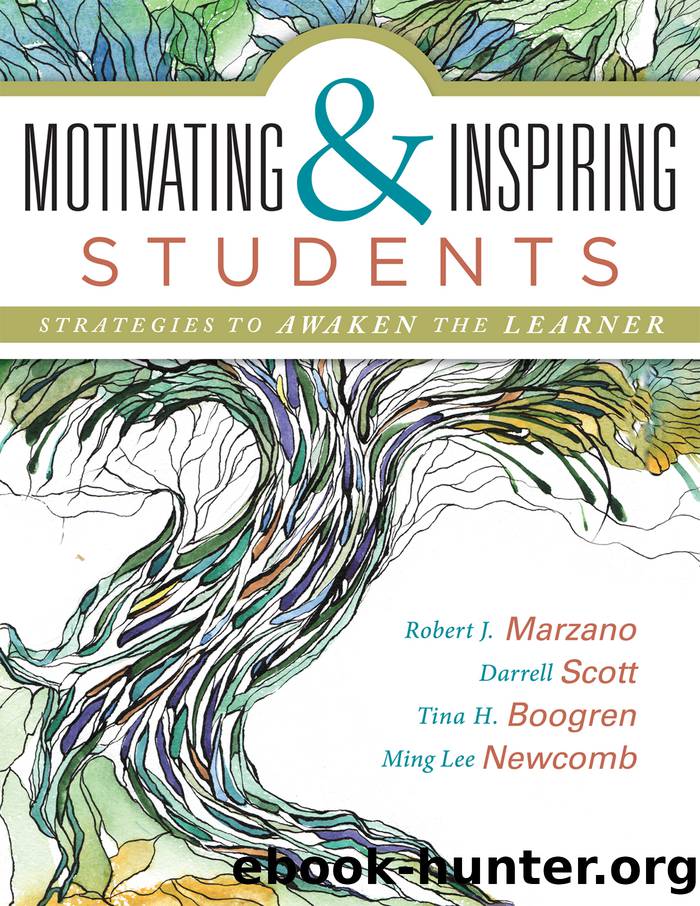Motivating and Inspiring Students by Marzano Robert J.;Scott Darrell;

Author:Marzano, Robert J.;Scott, Darrell;
Language: eng
Format: epub
Publisher: Marzano Resources
Published: 2019-08-15T00:00:00+00:00
Recognition
One of the easiest ways to build studentsâ esteem is to recognize individual students, their abilities, and their achievements. In a classroom setting, studentsâ esteem derived from others has two sources: (1) peers and (2) teachers. As such, teachers can find ways to reward and recognize students when appropriate while also encouraging active appreciation for their classmates.
Peer Recognition
Studentsâ esteem from others is directly tied to how they believe their peers perceive them. Unfortunately, many students may be too embarrassed to express affection or admiration for other students and their accomplishments, abilities, or traits. To combat this tendency, teachers can use specific strategies that require students to recognize their peers and the value they add to the classroom. Here, we provide two strategies that encourage students to articulate their appreciation for their classmates: (1) student interviews and (2) compliments.
Student Interviews
One aspect of recognition relates to having other people recognize an individualâs complexities or uniqueness. To help students understand their classmates as individuals with unique interests and accomplishments, teachers can ask students to briefly interview one another. For example, a teacher might choose to start each class period by having students spend five minutes interviewing one another about their interests, hobbies, and accomplishments. The teacher would continue this activity throughout the year until each student in class has interviewed all of his or her classmates. As students interview their classmates, the teacher might prompt them to identify one unexpected thing they learned or something they found to be notable about their partner. This can be a particularly powerful activity in the beginning of the year to help students get to know one another and to create a sense of belonging (page 95).
Alternatively, teachers might assign partnersâpreferably two students who rarely interactâand ask the pairs to conduct more in-depth interviews of one another. With this activity, students may spend anywhere from fifteen to thirty minutes learning about their partnersâ backgrounds, families, interests, achievements, beliefs, and other unique characteristics. After both partners have interviewed each other, students can share their findings with the class. To guide these presentations, teachers can provide students with the following questions.
⸠What is one thing you learned about your partner that you found surprising?
⸠What is one strength of your partner? Why?
⸠What is one notable thing that you learned about your partner?
⸠If you had to describe your partner in three adjectives, what would they be?
⸠What are your partnerâs interests? How does that affect who he or she is as a person?
Teachers should remind students that the reports should be positive and are designed to help the class get to know its members. As such, students should also provide background knowledge about their partners that may be relevant. After a student is finished presenting, the rest of the class asks the student questions about his or her partner. If a presenting student does not know the answer to a question, their partner directly answers it. The anticipation of other classmatesâ questions also encourages students to engage in more in-depth interviews.
Download
This site does not store any files on its server. We only index and link to content provided by other sites. Please contact the content providers to delete copyright contents if any and email us, we'll remove relevant links or contents immediately.
The Art of Coaching Workbook by Elena Aguilar(50168)
Trainspotting by Irvine Welsh(21078)
Twilight of the Idols With the Antichrist and Ecce Homo by Friedrich Nietzsche(18324)
Fangirl by Rainbow Rowell(8819)
Periodization Training for Sports by Tudor Bompa(7947)
Change Your Questions, Change Your Life by Marilee Adams(7405)
This Is How You Lose Her by Junot Diaz(6476)
Asking the Right Questions: A Guide to Critical Thinking by M. Neil Browne & Stuart M. Keeley(5388)
Grit by Angela Duckworth(5322)
Red Sparrow by Jason Matthews(5226)
Paper Towns by Green John(4826)
Room 212 by Kate Stewart(4768)
Ken Follett - World without end by Ken Follett(4467)
The Sports Rules Book by Human Kinetics(4099)
Housekeeping by Marilynne Robinson(4085)
Double Down (Diary of a Wimpy Kid Book 11) by Jeff Kinney(3959)
Papillon (English) by Henri Charrière(3942)
The Motorcycle Diaries by Ernesto Che Guevara(3804)
Exercise Technique Manual for Resistance Training by National Strength & Conditioning Association(3798)
